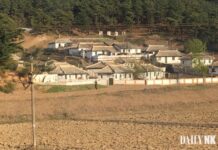[imText1]The World Food Programme (WFP) revealed that North Korea had for the first time admitted that they were lacking a million ton of food.
Recently, Tony Banbury, WFP Asia Director spent 3 days on location with officials from the North Korean Agriculture Ministry and Foreign Ministry where the food situation was discussed.
On the 26th, Banbury told Reuters, “This is a very significant development that they themselves are confirming they have a gap of 1mn tones.”
Director Banbury informed that the WFP and other sources had provided for North Korea’s food variance which equated to about 20% of the nations needs, however that these sources had already been wasted.
Disputably, these figures made by Mr. Banbury do not correspond to the figures on North Korea’s crop yields. Some even criticize that it was inappropriate of the WFP to directly quote comments made by North Korean officials.
According to a source by the DailyNK, the cost of rice has remained at 800~900 won(US$0.25~0.29). Especially with the forthcoming cyclic hardships of spring harvest, these figures suggest that market costs are actually stabilizing.
Since the breakdown of the distribution system, many North Koreans have resorted to purchasing rice at the markets. In North Korea, the cost of rice is a good representation of market conditions, and considering that rice prices are showing constancy is evidence that there have not been drastic setbacks as a result of the rice distributions.
In comparison to last year where flooding made the food crisis chronic in various districts throughout North Korea, the situation hasn’t really deteriorated. Rather, the continuous inflow of food and hence trade from China has helped maintain market prices, North Korea-China tradesmen say.
Earlier this year, the Rural Development Administration in South Korea estimated North Korea’s food production to be 4.3mn tons. Evidence from a defector who once worked at North Korea’s food distribution ministry and past analysis on crop production suggests that North Korea would not have incurred a food crisis in the case it had produced more than 4mn tons of output.
Simply put, 4.3mn tons of production is at the least enough to maintain the lives of North Korean citizens. Undoubtedly, in a society like North Korea, this figure could initiate a food crisis and starvation in the lower class. However, inflating the shortage of food may only cause exhaustion of essential aid.
In addition, some argue that international organizations are actually provoking this vicious cycle in North Korea by decreasing the real amount of food produce.
Recently, North Korean analyst Marcus Noland published a report, ‘Famine in North Korea’ where he argued that about 50% of international food aid was being consumed by the military and, or the elite class.
In the report, he said, “The North Korean government consistently sought to frustrate transparent, effective humanitarian relief” and that, “Diversion is almost certainly occurring on a large scale, enough food to feed between 3 to 10 percent or more of the North Korean populace. Some of this aid is almost surely consumed by politically connected groups, including the military.”
















